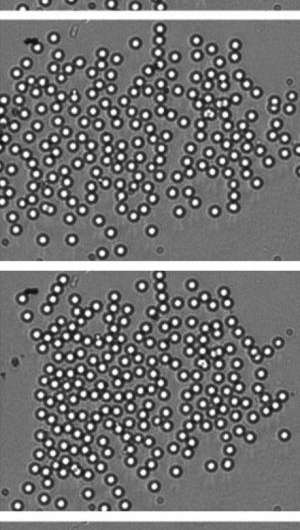Controlling particles for directed self-assembly of colloidal crystals

(Phys.org)—Researchers from the NIST Center for Nanoscale Science and Technology and the Johns Hopkins University have developed a technique to reliably manipulate hundreds of individual micrometer-sized colloid particles to create crystals with controlled dimensions. The accomplishment is an important milestone for understanding how to direct and control the assembly of microscale and nanoscale objects for nanomanufacturing applications.
The experiment uses four electrodes patterned on a microscope coverslip to move the micrometer-sized particles suspended in liquid by applying a combination of AC and DC electric fields. Using a nonuniform, high-frequency AC field, the dielectrophoretic forces exerted on the dielectric particles are tuned to adjust the strength of their attraction to a collection area in the center of the electrodes. When these forces are low enough, electrophoretic-electroosmotic flows induced by applying a DC field allow the researchers to selectively remove particles from the area and trim the particle assemblies to a chosen size and shape.
By independently varying the AC and DC electrode potentials, the researchers can direct the self-assembly of two-dimensional (2D) rafts made of precise numbers of particles; i.e., 2D colloidal crystals. Once the desired crystal size is reached, the attractive forces holding the particles in the collection area are increased to stabilize the structure. An important component of this work is the application of a computer vision-based, real-time feedback system that dynamically adjusts the AC and DC fields to automate the directed assembly process.
This work shows how the combination of multiple actuators offers extra degrees of freedom that can be used to manipulate ensembles of colloidal components to create desired sizes and shapes. The researchers are now developing measurement methods sensitive enough to track nanometer-scale structures that will allow these methods to be extended to control the assembly of nanoscale materials.
More information: Juarez, J. et al., Multiple electrokinetic actuators for feedback control of colloidal crystal size. Lab on a Chip 12, 4063–4070 (2012). pubs.rsc.org/en/Content/Articl … g/2012/LC/c2lc40692f
Journal information: Lab on a Chip
Provided by National Institute of Standards and Technology


















